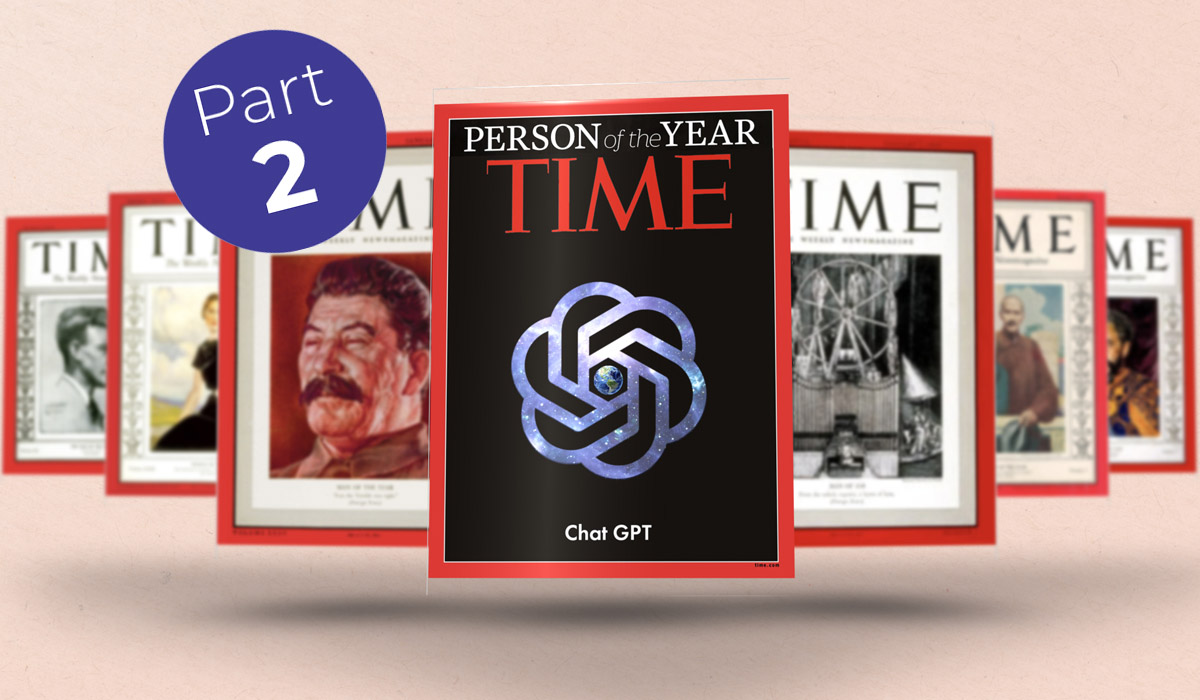Listen to the article
Part 2
Apart from the fact that Chat GPT is not a person, the strongest argument that could stand in the way of its place in Time’s pantheon of powerful and famous, is its inability to distinguish lies from truth or good from evil, that is, a lack of any value criteria. This claim might hold if there was any idea in the propositions that Time’s Person of the Year must suffer from the same value criteria as the editorial staff of this magazine. In fact, there are a number of people who prove the exact opposite.
Let’s start with the King of Ethiopia, Haile Selassie, laureate of 1935. A billion dollars, his personal fortune, may not seem that large today. But to the people under his rule, it could have helped them overcome some of the most basic life challenges, such as not dying from hunger. These wealth disparities created certain tensions in society, so it was only natural for Selassie to have a ruling title that would evoke awe and respect among his subjects. Such a title may have seemed like a good idea at the time, but today, it would surely cause problems when trying to buy an airplane ticket online. It is unclear how he would manage to enter – By the Conquering Lion of the Tribe of Judah, His Imperial Majesty Haile Selassie the First, King of Kings, Lord of Lords, Elect of God – in a field where people define their status by choosing between Mr, Mrs, or Other.
Or, for example, Wallis Warfield Simpson, the 1936 laureate, for whom King Edward VIII abdicated the throne of the United Kingdom. Time magazine describes her as the most written and gossiped about woman of that year, without mentioning her casual flirtation with the Foreign Minister of Hitler’s Germany, von Ribbentrop, who sent her a bouquet of 17 carnations every day during his stay in London. Each flower in the bouquet allegedly represented one of their romantic encounters. As for the nature of these encounters, we can only say that the Internet is too polite a place to write about them in more detail. Dark web included.
Did you miss: Will Chat GPT become Time Magazine’s Person of the Year? – Part 1
Also, on the list is Chiang Kai-shek, Time’s Person of the Year for 1937, founder and long-time dictator of Taiwan, whose political and military career left behind, according to conservative estimates, around four million dead.
Stalin would probably ask Chiang Kai – Who?! Because in Stalin’s jargon, four million dead could also be referred to as – a lazy Wednesday before lunch. And yet, the leader of the USSR, Joseph Vissarionovich, was chosen for the list twice – in 1939 and 1942. His final death toll of compatriots was somewhere between twenty and sixty million. Indeed, compared to a man whose statistical error in calculating the dead amounts to forty million people, Chiang Kai-shek would be a pitiful name for a dictator.
Among Time’s laureates are also China’s paramount leader Deng Xiaoping, General Secretary of the Communist Party of the Soviet Union Yuri Vladimirovich Andropov, and the leader of the Islamic Revolution in Iran, Ayatollah Khomeini. It would be difficult to say with certainty which of these three differs the most in values from the editorial board of a Western liberal magazine.
We will not delve too deeply into the details of the rule of any of them, but we can say that, despite their numerous differences, all three would fall into the category – least likely persons to make it on TikTok.
And finally, or rather before all, among the people who surely do not share the values of Time magazine’s editorial board would be the 1938 laureate – Adolf Hitler.
In defense of Time Magazine, when Hitler was the recipient, instead of a portrait, the cover was illustrated with a medieval engraving – From the unholy organist, a hymn of hate. In the editor’s introduction, it was written that Hitler was “the greatest threatening force that the democratic, freedom-loving world faces today.” Hitler would probably say – Yeah, You don’t really mean that, you’re just flattering me. However, there is some truth to Putin’s stance that Time Magazine has not always had a clear moral compass in choosing recipients for this flattering title.
Namely, in 2007 the recipient was Putin himself, and the magazine described him as a man who “stands, above all, for stability.” So, that description has not aged well. In fact, we can say that only Putin, and perhaps, the malevolent archaeologist from Indiana Jones whose face melted upon seeing the contents of the Lost Ark, has aged worse.
The latest choice that sparked strong reactions occurred in 2016 when the Person of the Year was Donald Trump, toward whom the editorial board discreetly indicated their stance: on the magazine’s cover, the tops of the letter ‘M’ from Time’s logo peeked out just behind Trump’s head, like red horns. Trump was very grateful for the title and took it as a great honor. We do not know whether it was because he did not understand the joke, or if he actually liked the horns. The whole series of Time’s Persons of the Year clearly did not have significantly better moral and value-based criteria than Chat GPT. And almost every laureate on this list would laugh at the claim that artificial intelligence poses the greatest danger to humanity, alongside their young and cheerful faces on the cover pages.
But, not all recipients of this flattering title made the list simply because of the sheer power they wielded. Many of them seemed like a good choice at the time. Although today’s editorial board would probably gladly replace each of them with Mr. Potato Head, Cookie Monster, or Wile E. Coyote, the would-be killer of an annoying bird. We will say more about each of them in the next installment in a few days.
Did you miss: Will Chat GPT become Time Magazine’s Person of the Year? – Part 1







